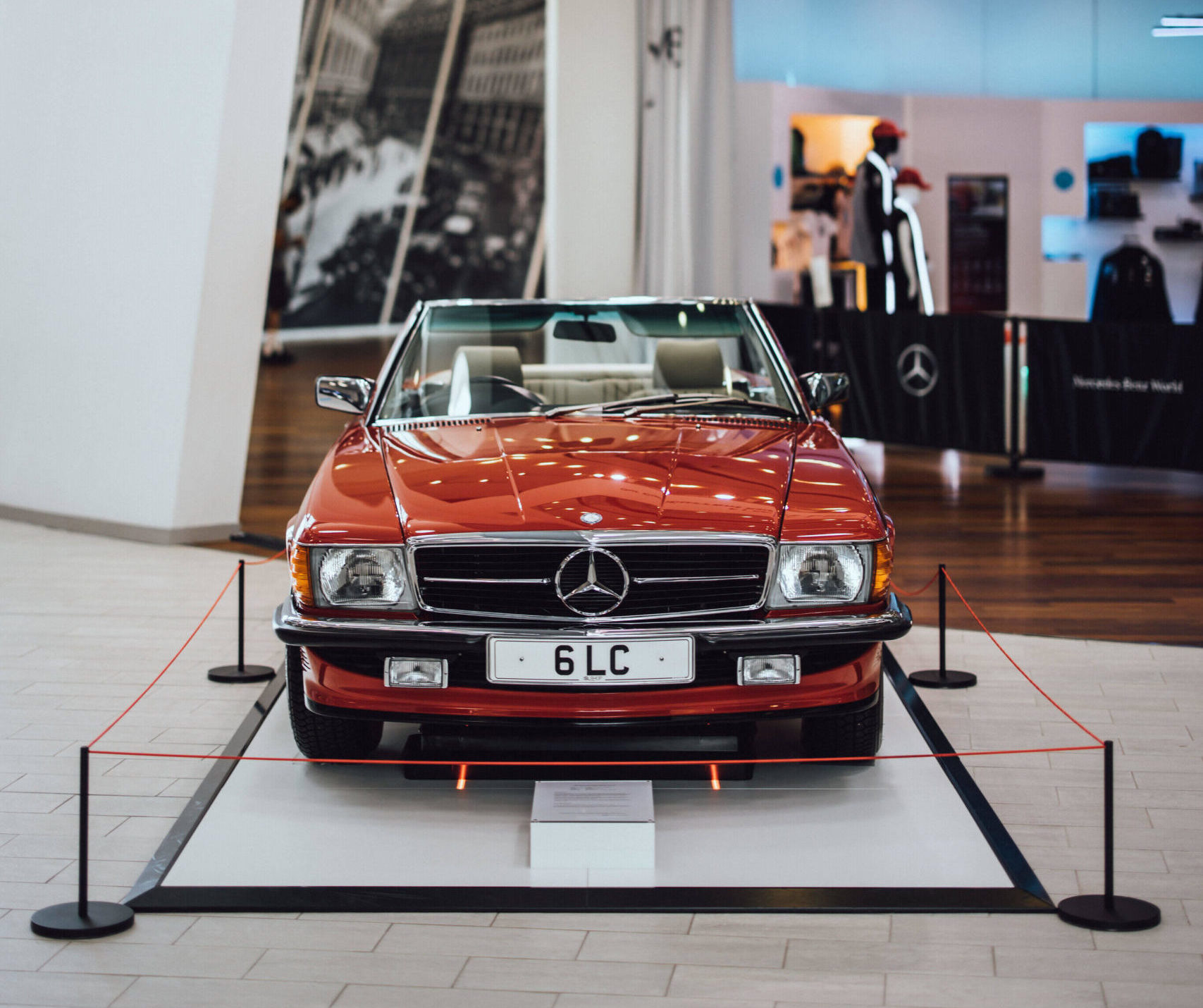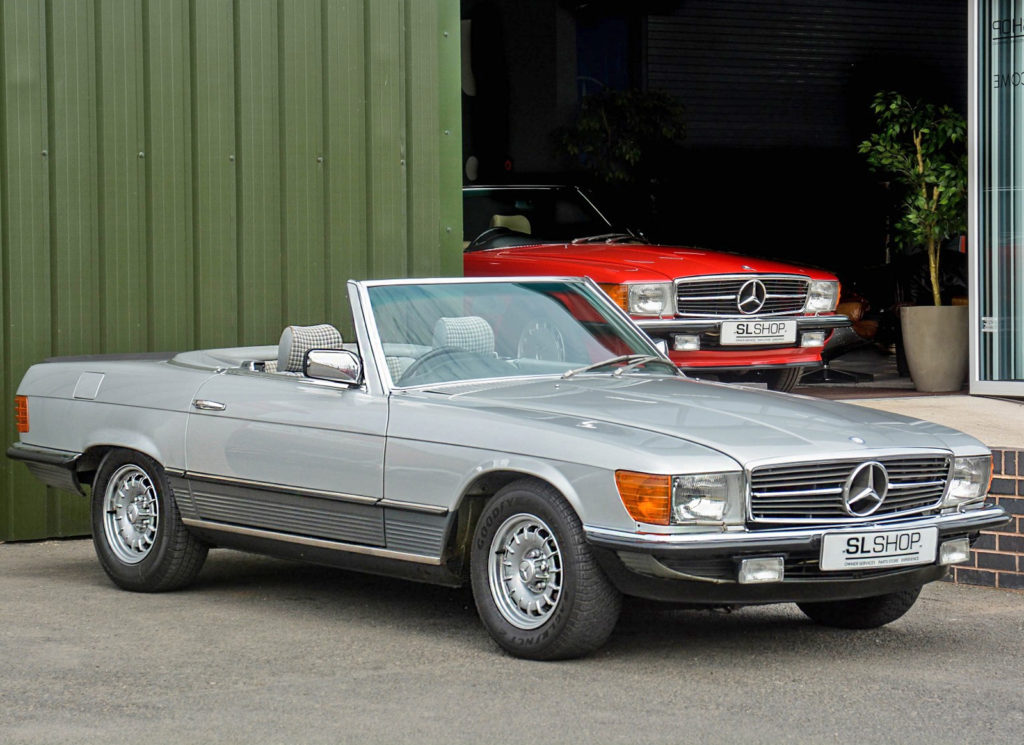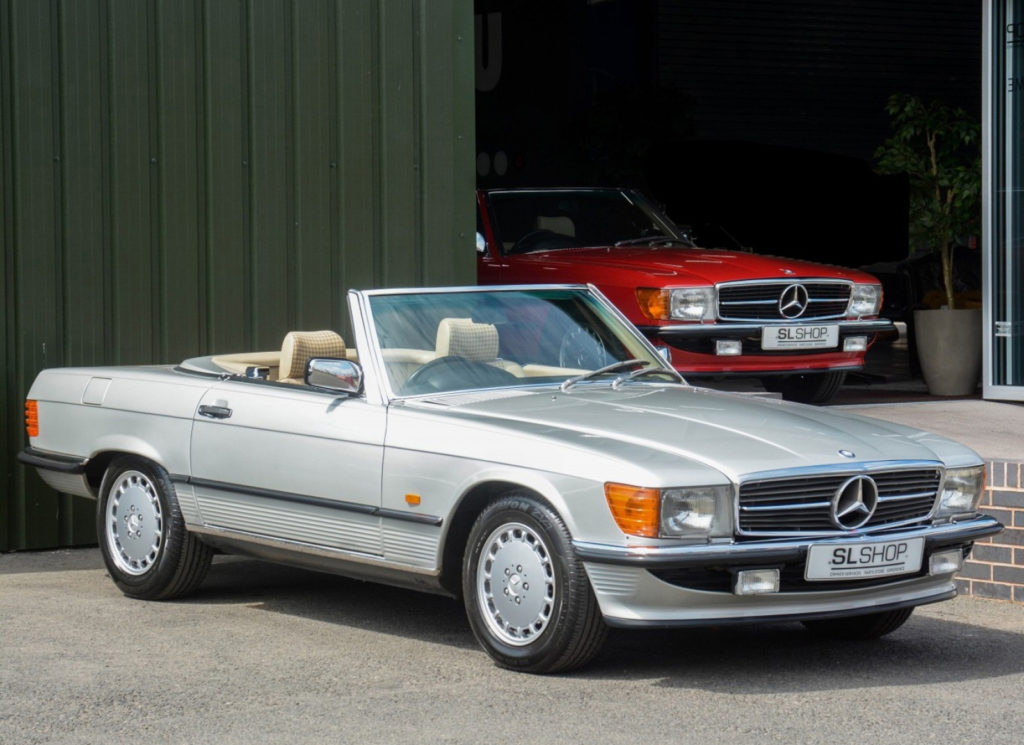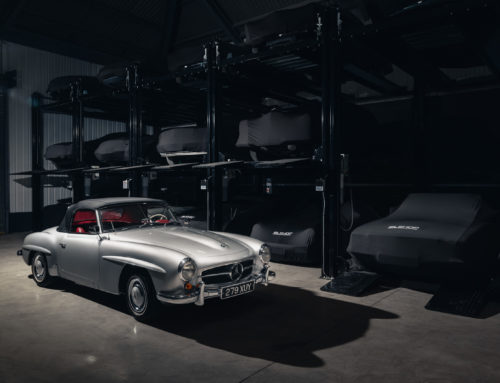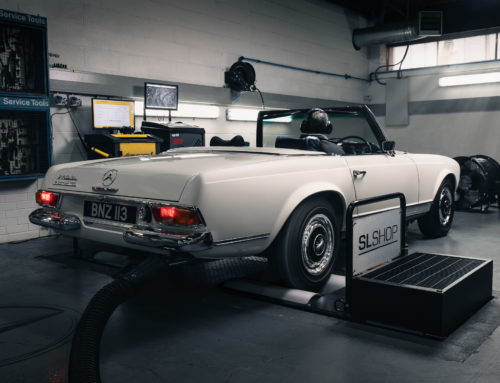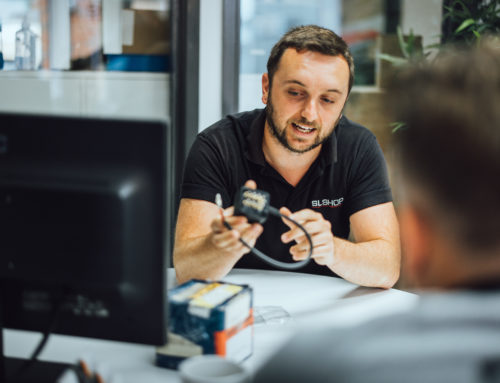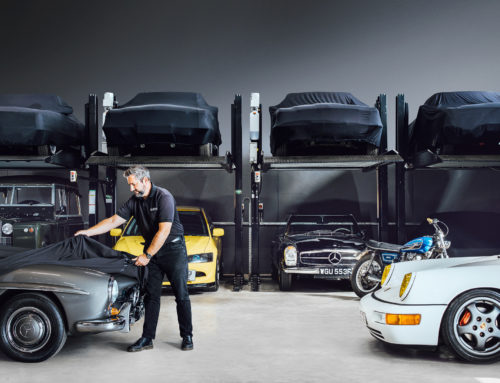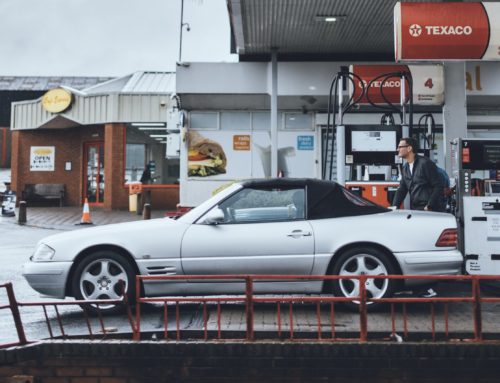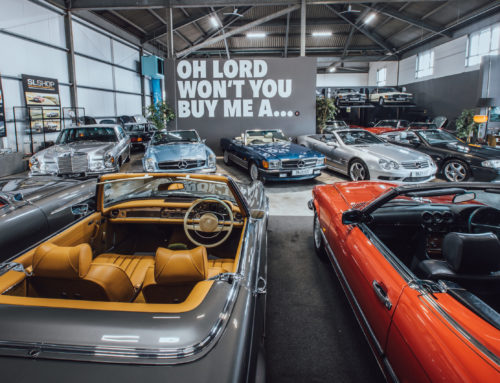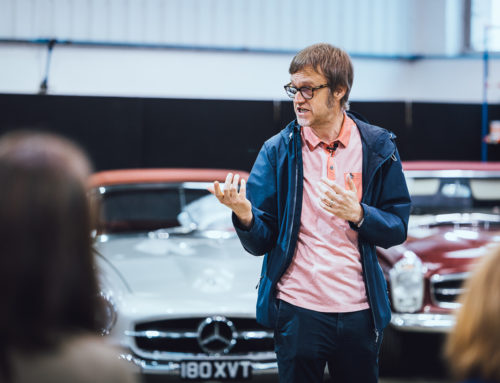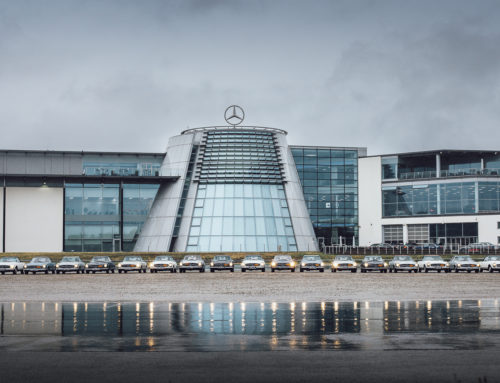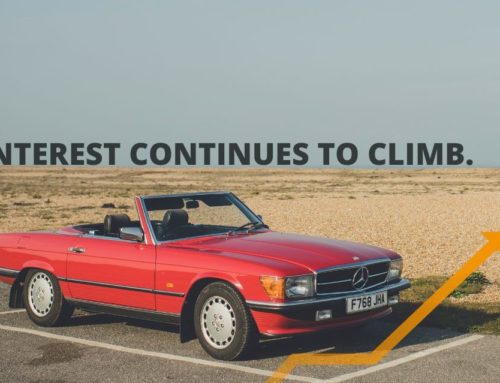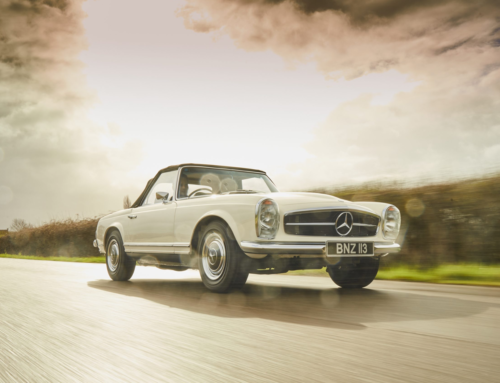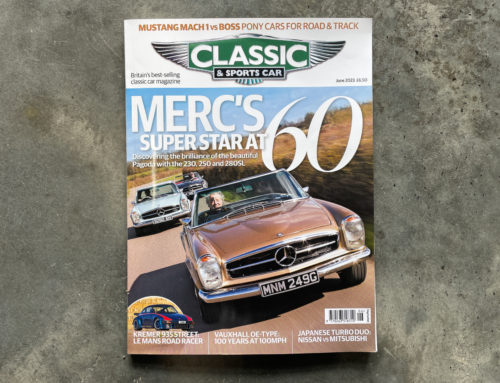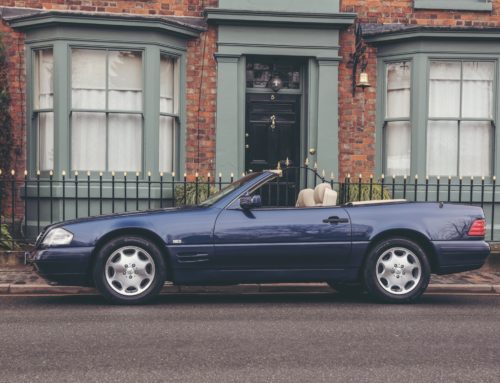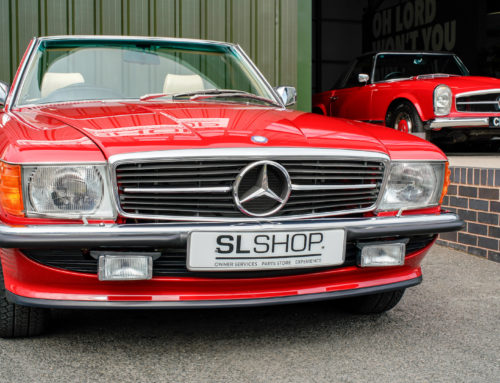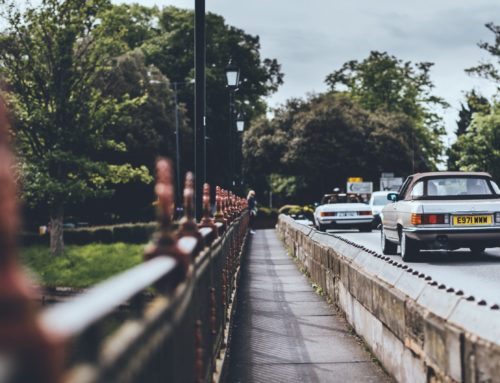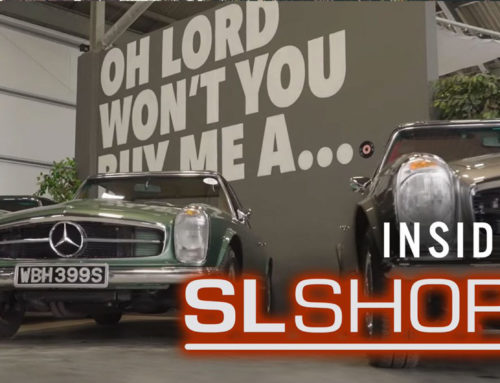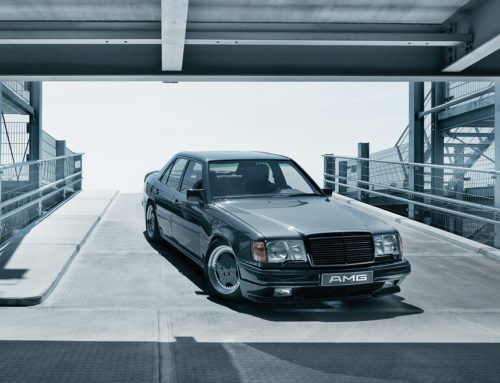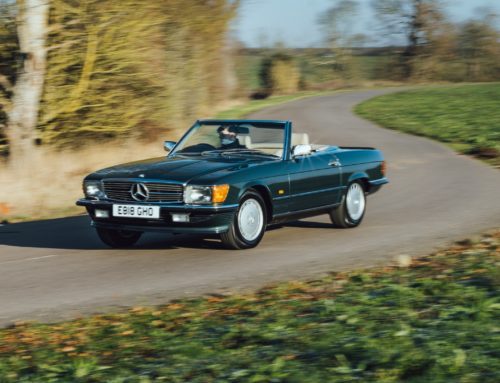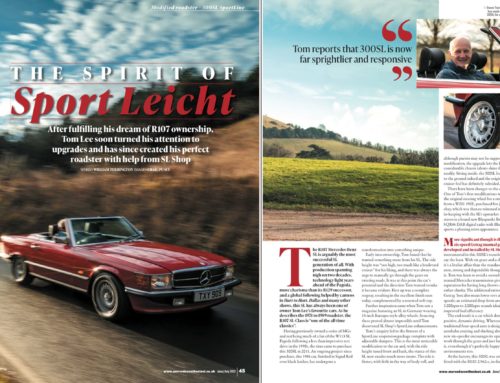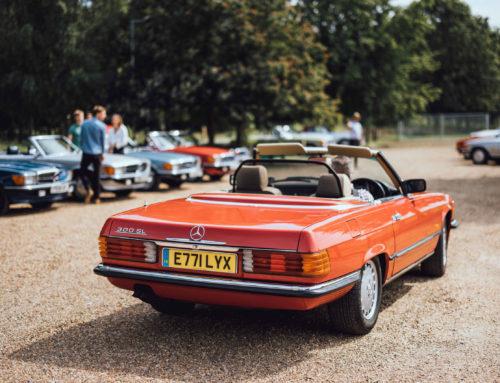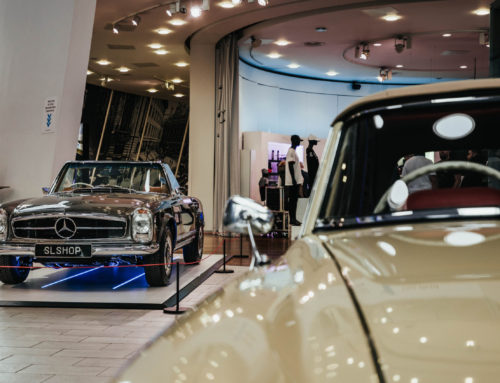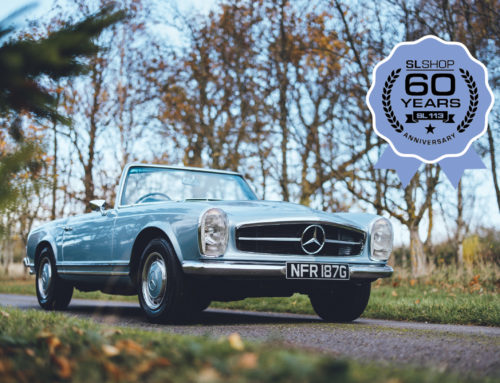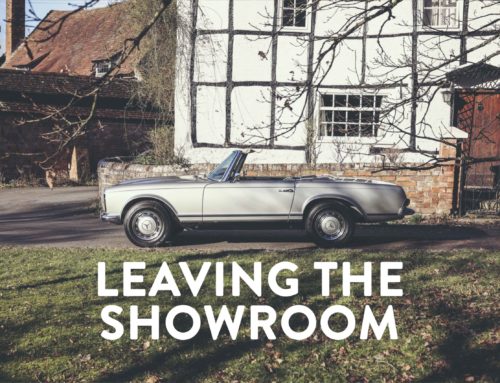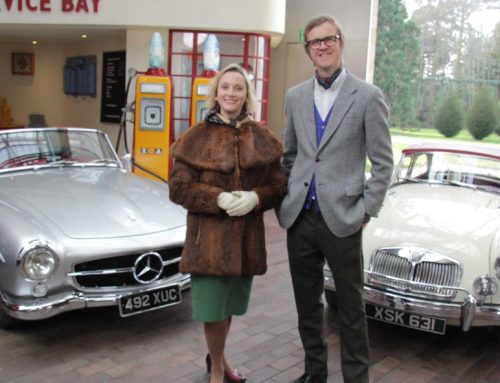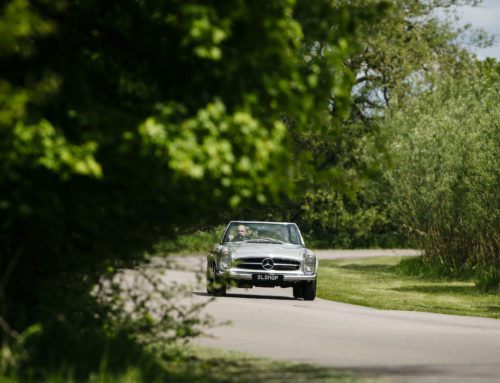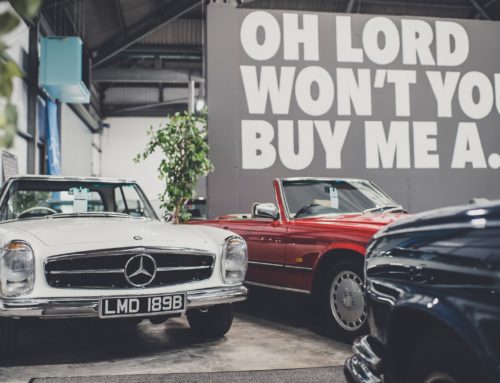THE R107 SL OVER THE YEARS
From racing sports car to best selling roadster – discover how the Mercedes-Benz W107 SL evolved into a favourite among the rich and famous and now thrives as a classic from yesteryear.
The grandfather of the Mercedes W107 was made not for the road, but for the race track. The W194 SL racing sports car of 1952 featured streamlined bodywork made from aluminium-magnesium sheet metal, a space frame chassis, and a three-litre straight-six producing 168bhp. It competed in the Berne Grand Prix, won Le Mans, and even took victory in the gruelling Carrera Panamericana road race in Mexico.
The first Mercedes-Benz SL road car was built from August 1954, and was called the W198 300SL, sharing its race car relation’s space frame construction, and boasting a new ‘gullwing’ door concept which inspired the car’s Gullwing nickname.
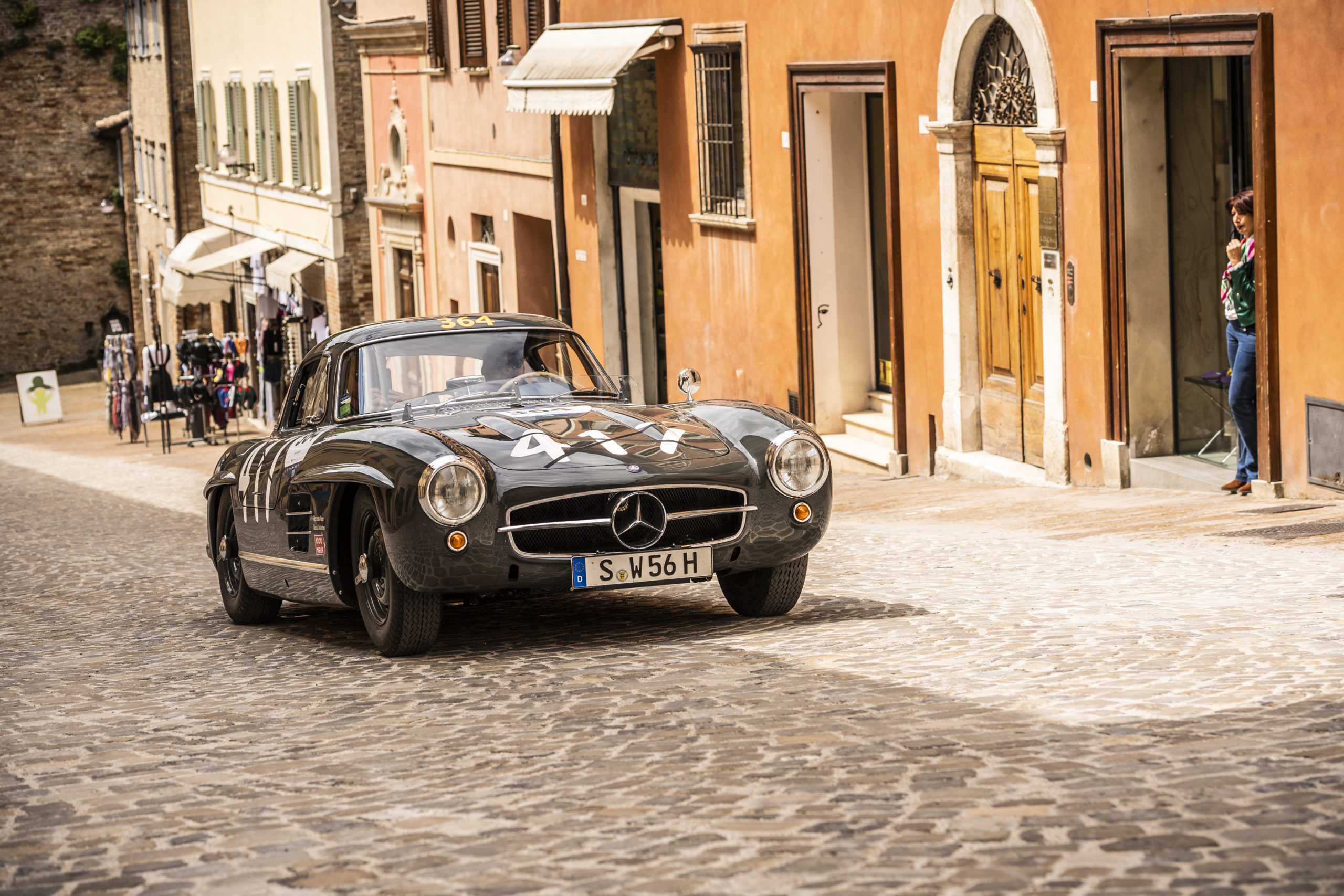
16.05. – Mille Miglia 2019 – Photo Press, Challenge GmbH, Route Milano Marittima-Rom
The driving force behind the 300SL road car’s existence is attributed to American car dealer Max Hoffman, who saw great potential in the marketability of such a project and convinced the board of directors at Mercedes-Benz with his enthusiasm and unwavering belief in the idea.
Thanks to fuel injection, power from the three-litre straight-six was now up to 212bhp and the 300SL road car could achieve a maximum speed of 162mph depending on the rear axle ratio.
A W198 300SL Roadster followed in 1957, and in many ways set the template for all future SL models, featuring a folding fabric roof and optional hardtop.
The W121 190SL Roadster and rare Coupe arrived in 1955, and these compact two-seaters were very different propositions to the W198 Roadster, using a Ponton saloon derived, 1.9-litre four-cylinder engine and suspension. This was a comfortable and and elegant GT car, rather than a thoroughbred racer like its W198 cousins.
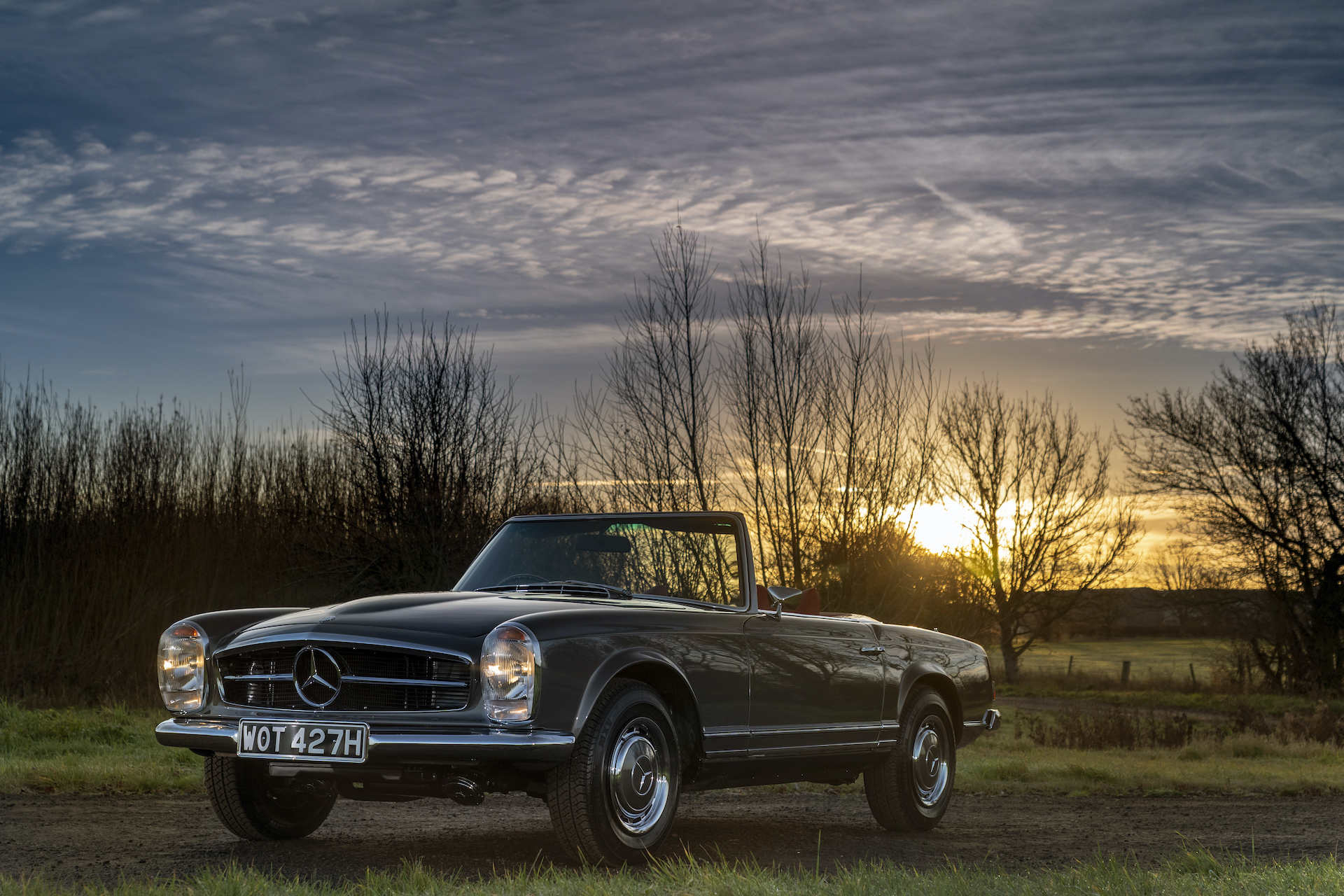
The W113 Mercedes Pagoda
Mercedes’ W113 230SL was launched at the Geneva motor show in March 1963, and sought to combine sporty dynamics with improved GT credentials. This was a small roadster that could inspire its drive one minute, and relax them the next. It also had one eye on providing excellent safety protection for its occupants, constructed with pioneering crumple zones and padded cabin appointments.
The car owes its ‘Pagoda’ nickname to the concave shape of its removable roof, which was designed by safety genius Béla Barényi. As well as looking classy, the roof’s shape is said to provide a high degree of stiffness, while providing excellent all-round visibility through its large glass areas.
As with the 190SL, the 230SL was offered as a Roadster with collapsible fabric hood, as a Coupe with removable hood, and as a Coup with removable hood and a roadster hood. All three versions could optionally be fitted with a transverse seat in the rear.
Apart from the standard four-speed manual gearbox, for the first time an SL model was available with an optional four-speed automatic transmission. A third version came in May 1966 – a five-speed gearbox, produced by the Zahnradfabrik Friedrichshafen (ZF).
The 230SL was replaced by the 250SL in late 1966/early 1967, with engine capacity up from 2.3 litres to 2.5 litres, and torque increased to 145lb ft to 159lb ft (power remained at 148bhp). The six-cylinder engine (now codenamed M129, previously M127) also received seven camshaft bearings enhancing refinement and mechanical durability.
Braking performance was also improved, and the fuel tank capacity was increased from 65 litres to 82. Mercedes-Benz also saw fit to install an oil cooler.
A fourth version of the 250SL was launched in March 1967 – a Coupe model with seats in the rear and no folding fabric roof. This car became known as the ‘California’.
Just a year later, in 1968, the 250SL was replaced by the 2.8-litre 280SL, featuring a 168bhp M130 motor. Apart from the model badge, the 280 SL could only be differentiated from the two predecessor models by the wheel trim.
Production of the SL Pagoda ended in March 1971 and totalled 48,912 unit; the 230SL achieved 19,831 of those, the 250SL 5,196, and the 280SL 23,885.
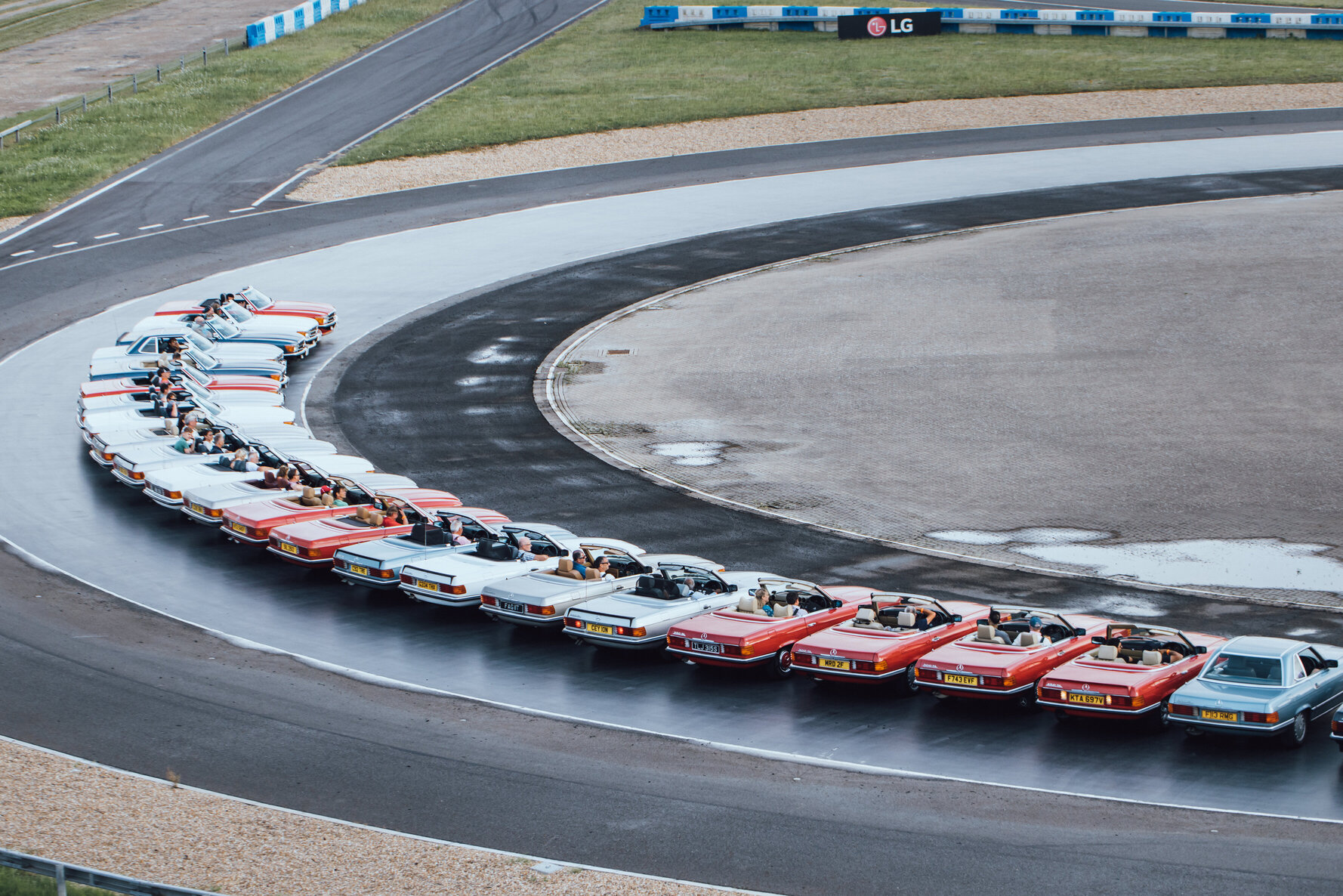
The Cult W107 SL
The Mercedes W107 or ‘R107’ SL Roadster was produced from spring 1971 through to August 1989, and to this day boasts the longest production run of any three-pointed star.
The R107 SL took the chassis components of the mid size W114 saloon and mated them to V8 engines derived from that in the W111 280SE 3.5, the result a chassis with double-wishbone front suspension and a semi trailing arm rear axle, plus recirculating ball steering – and a lot of power.
The Mercedes W107 SL was essentially a two-seat convertible/roadster with fabric soft top and hardtop as standard, although it is often seen with two additional ‘jump seats’ in the rear. The SLC (C107) derivative launched months later was a two-door hardtop coupe with more usable rear seats, and was in effect an SL stretched 360mm and given a fixed roof.
Although some may refer to the SLC as simply an ‘SL coupe’, it was positioned as an S-Class coupe type vehicle, replacing the W111 Coupe in Mercedes’ line up. The SLC was replaced earlier than the SL, in 1981, by the much larger 126-series SEC. The SLC was aimed at the same market as more exotic machines such as the Jaguar E-Type and Citroën SM.
Mercedes-Benz manufactured 237,287 R107 SLs, and around two thirds of those were sold in North America – their footprint on the road dwarfed the Pagoda’s and allowed engineers to create more interior space.
Volume production of the first Mercedes W107 car, the 350SL, started in April 1971 alongside the last of the W113 cars. Early North American cars wore the name 350SL, but had a larger 4.5-litre V8 (and were renamed 450SL/SLC for model year 1973); the big V8 became available on other markets with the official introduction of the 450SL/SLC in non North American markets in March 1973.
From July 1974, both the Mercedes W107 SL and SLC could also be ordered with a fuel-injected, 2.8-litre straight-six, badged 280SL and 280SLC.
Following the discontinuation of the SLC in September, 1981, the 107-series continued initially as the 280S, 380SL and 500SL. At this time, the V8 engines were re-tuned for greater efficiency, lost a few bhp and consumed less fuel, helped by substantially numerically shorter axle ratios (that went from 3.27:1 to 2.47:1 for the 380SL, and from 2.72:1 to 2.27:1 for the 500SL). From September 1985, the 280SL was replaced by a new 300SL, and the 380SL by a 420SL; the 500SL continued and a 560SL was introduced for the USA, Australia and Japan.
The final R107 SL was built on August 4 1989 – a 500SL finished in Astral Silver, which now resides in the Mercedes-Benz Museum in Stuttgart, Germany.
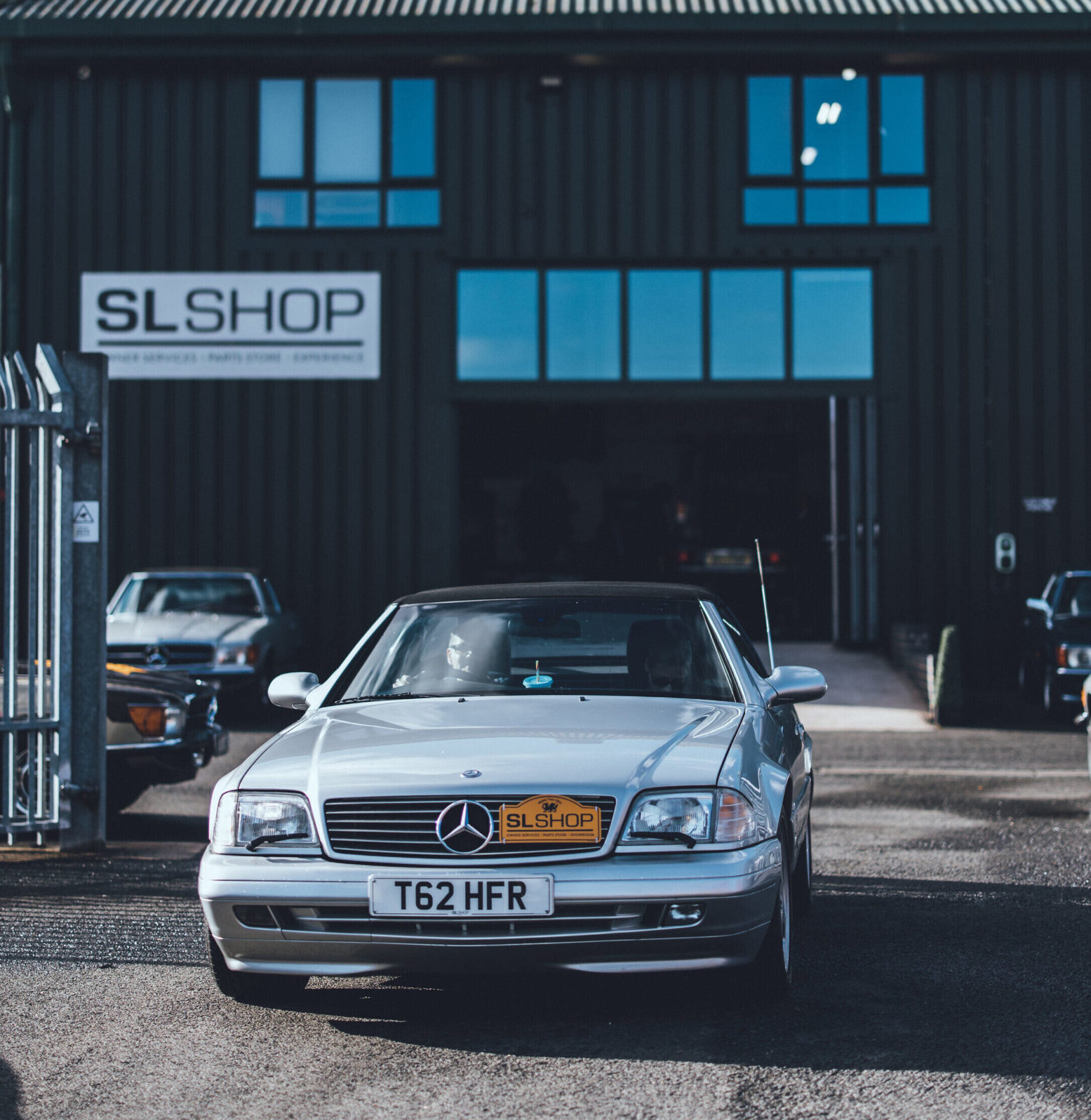
The R129 SL took over from the R107 and was built until 2001. It was the first SL to feature a V12 engine, in the 600SL/SL600 model, and took safety to the next level with its modern construction, pop-up rollover bar, plethora of airbags, and Electronic Stability Programme – ESP – offered from September 1995.
Mercedes-Benz also developed Brake Assist for the R129 SL, a system able to recognise emergency braking situations and, if required, to boost brake power to maximum more quickly than was previously the case, thereby shortening stopping distances considerably.
Facelifts came in 1995 and 1998, the latter seeing new V6 (M112) and V8 (M113) engines replacing the old straight-six and eight-cylinder motors.
Mercedes tuner AMG was also well into the game by this time, having become an official partner from 1993 and incorporated into the Daimler family in January 1999. This arrangement saw the creation of the V8 powered SL60 AMG (376bhp) and SL55 AMG (349bhp), and the 7.3-litre V12 engined SL73 AMG (518bhp).
By the time production of the R129 SL ended in July 2001, Mercedes-Benz had completed the manufacture of 204,940 examples.
The succeeding R230 SL launched in July 2001 and was built until late 2011, replaced by the R231 generation SL and now the R232 SL generation of 2022.
- A pre-facelift R107 SL
- A post-facelift R107 SL
MERCEDES W107 SL TIMELINE
Development of the R107 SL began at the end of the 1960s, with the intention of replacing the W113 SL Pagoda. The R107 SL would be the first Mercedes-Benz to use the ‘R’ designation in its model number, denoting ‘Roadster’, but it is common for enthusiasts and specialists to still refer to the model as the W107 due to the commonality of the ‘W’ preceding the majority of the Mercedes-Benz model range.
The R107 SL was launched in spring 1971 and continued in production until August 1989, such was its popularity with buyers all over the world. The silhouette of the 107 is distinctive, handsome and stylish without looking dated or tired. A good example of an R107 SL will be more than just an appreciating asset, it’s a true classic car that can be used and enjoyed.
1971
Volume production of the W107 SL starts in March/April with the 350SL, it’s 3.5-litre V8 producing 197bhp.
1973
450SL model arrives with a 4.5-litre V8 making 222bhp.
1974
A straight-six powered 280SL is created in response to the ongoing oil crisis in the Middle East, offering better fuel economy than the V8 models.
1975
Between November 1975 and February 1976, the 350SL, 450SL and 280SL switch to a new Bosch D-Jetronic fuel injection system to meet tough new emissions targets. The power and torque of these models is reduced slightly as a result.
1980
Facelifted R107 SL is presented at March’s Geneva motor show, featuring minor cabin tweaks including an updated steering wheel design shared with the 116-series S-Class. A new four-speed automatic replaces the ageing three-speeder, and the light alloy engines from the S-Class are introduced to the SL range in modified form. A new five-litre V8 powered 500SL is launched with 237bhp. Meanwhile, the 350SL is replaced by the 3.8-litre 380SL (215bhp). The 280SL carries on as before.
1981
In autumn, the 380SL and 500SL V8s are modernised under the ‘Mercedes-Benz Energy Concept’, which is designed to reduce fuel consumptions and emissions. As a result, the compression ratio is increased, the camshaft timing altered, new injection valves are fitted, and idling is now controlled by electronics. The altered valve timing brings the benefit of maximum torque occurring lower down in the rev range, and even increasing in the case of the 380SL. Rear axle ratios are also tuned to the new engine characteristics.
1985
Another facelift for the R107 SL, presented at the Frankfurt motor show in September, brings minor external changes including 15-inch wheels (up from 14-inch), improved front wheel suspension, and a new range of engines. The three-litre 300SL (185bhp) straight-six replaces the 280SL, and the 4.2-litre 420SL V8 (215bhp) usurps the 380SL. The 500SL receives electronic ignition and Bosch KE-Jetronic electro-mechanical injection control, boosting output to 242bhp. A new 5,547cc 560SL V8 is also launched, its output quoted as 227bhp due to a catalytic converter. Sadly, this model is made available only in North America, Australia and Japan.
1989
In August 1989, the 237,287th and final R107 SL rolls of the Sindelfingen production line – a 500SL finished in Astral Silver metallic, which soon takes pride of place in the Mercedes-Benz Museum in Stuttgart. The succeeding R129 SL made its public debut at the Geneva motor show in March.
THE SL MARKET
Despite the continued doom and gloom of the Brexit vote and climate change, the impact on the classic car industry appears to have been minor.
A slow July was followed by an impressive August as the market stabilised and customers realised that Europe hadn’t gone into financial meltdown – consumer confidence was restored and it was very much business as usual.
Demand for good, high-end cars remains strong. Low mileage, high quality, late model 300, 420 and 500SLs still rank as the most desirable, but late 500SLs are becoming increasingly difficult to source. Blue and black cars with cream leather are always sought after and sell instantly, with the iconic Signal Red remaining as popular as ever.
For the first time in a number of years, we are fielding more enquiries regarding pastel yellow, green and brown examples that were so popular in the 1970s; these early cars are a great buy, offering more car for the money if you prefer the character of early R107s.
As the gulf between the good, the bad and the ugly widens, it becomes increasingly more important to buy the very best example that’s available. A high-quality restoration of an R107 SL can quickly reach six figures – another reason why the price for good examples continues to climb.
Values of W113 SL Pagoda seem to have stabilised, with more movement seen in the W121 190SL market – those cars now regularly achieving significantly more than £100,000, particularly the RHD pre-1957 models as they possess the credentials to participate in races such as the Mille Miglia.
Elsewhere, we are seeing values of low mileage, mint condition R129 SLs increasing, particularly when it comes to excellent examples of the SL60 AMG. Classic Mercedes-Benz cars are all in demand, with coupes commanding larger prices than saloons or estates. Cabriolets lead the way though, particularly earlier cars such as the W111 and later dropheads such as the 124-series.
Our advice would be to move swiftly if you are intending to get into an SL of any age, and don’t hang about if you hanker after an R129 SL – they won’t stay this affordable forever. As more people recognise the need to enjoy the final years of the combustion engine, these cars will become extremely sought after.
Share With Your Fellow Enthusiasts
THE R107 SL OVER THE YEARS
From racing sports car to best selling roadster – discover how the Mercedes-Benz W107 SL evolved into a favourite among the rich and famous and now thrives as a classic from yesteryear.
The grandfather of the Mercedes W107 was made not for the road, but for the race track. The W194 SL racing sports car of 1952 featured streamlined bodywork made from aluminium-magnesium sheet metal, a space frame chassis, and a three-litre straight-six producing 168bhp. It competed in the Berne Grand Prix, won Le Mans, and even took victory in the gruelling Carrera Panamericana road race in Mexico.
The first Mercedes-Benz SL road car was built from August 1954, and was called the W198 300SL, sharing its race car relation’s space frame construction, and boasting a new ‘gullwing’ door concept which inspired the car’s Gullwing nickname.

16.05. – Mille Miglia 2019 – Photo Press, Challenge GmbH, Route Milano Marittima-Rom
The driving force behind the 300SL road car’s existence is attributed to American car dealer Max Hoffman, who saw great potential in the marketability of such a project and convinced the board of directors at Mercedes-Benz with his enthusiasm and unwavering belief in the idea.
Thanks to fuel injection, power from the three-litre straight-six was now up to 212bhp and the 300SL road car could achieve a maximum speed of 162mph depending on the rear axle ratio.
A W198 300SL Roadster followed in 1957, and in many ways set the template for all future SL models, featuring a folding fabric roof and optional hardtop.
The W121 190SL Roadster and rare Coupe arrived in 1955, and these compact two-seaters were very different propositions to the W198 Roadster, using a Ponton saloon derived, 1.9-litre four-cylinder engine and suspension. This was a comfortable and and elegant GT car, rather than a thoroughbred racer like its W198 cousins.

The W113 Mercedes Pagoda
Mercedes’ W113 230SL was launched at the Geneva motor show in March 1963, and sought to combine sporty dynamics with improved GT credentials. This was a small roadster that could inspire its drive one minute, and relax them the next. It also had one eye on providing excellent safety protection for its occupants, constructed with pioneering crumple zones and padded cabin appointments.
The car owes its ‘Pagoda’ nickname to the concave shape of its removable roof, which was designed by safety genius Béla Barényi. As well as looking classy, the roof’s shape is said to provide a high degree of stiffness, while providing excellent all-round visibility through its large glass areas.
As with the 190SL, the 230SL was offered as a Roadster with collapsible fabric hood, as a Coupe with removable hood, and as a Coup with removable hood and a roadster hood. All three versions could optionally be fitted with a transverse seat in the rear.
Apart from the standard four-speed manual gearbox, for the first time an SL model was available with an optional four-speed automatic transmission. A third version came in May 1966 – a five-speed gearbox, produced by the Zahnradfabrik Friedrichshafen (ZF).
The 230SL was replaced by the 250SL in late 1966/early 1967, with engine capacity up from 2.3 litres to 2.5 litres, and torque increased to 145lb ft to 159lb ft (power remained at 148bhp). The six-cylinder engine (now codenamed M129, previously M127) also received seven camshaft bearings enhancing refinement and mechanical durability.
Braking performance was also improved, and the fuel tank capacity was increased from 65 litres to 82. Mercedes-Benz also saw fit to install an oil cooler.
A fourth version of the 250SL was launched in March 1967 – a Coupe model with seats in the rear and no folding fabric roof. This car became known as the ‘California’.
Just a year later, in 1968, the 250SL was replaced by the 2.8-litre 280SL, featuring a 168bhp M130 motor. Apart from the model badge, the 280 SL could only be differentiated from the two predecessor models by the wheel trim.
Production of the SL Pagoda ended in March 1971 and totalled 48,912 unit; the 230SL achieved 19,831 of those, the 250SL 5,196, and the 280SL 23,885.

The Cult W107 SL
The Mercedes W107 or ‘R107’ SL Roadster was produced from spring 1971 through to August 1989, and to this day boasts the longest production run of any three-pointed star.
The R107 SL took the chassis components of the mid size W114 saloon and mated them to V8 engines derived from that in the W111 280SE 3.5, the result a chassis with double-wishbone front suspension and a semi trailing arm rear axle, plus recirculating ball steering – and a lot of power.
The Mercedes W107 SL was essentially a two-seat convertible/roadster with fabric soft top and hardtop as standard, although it is often seen with two additional ‘jump seats’ in the rear. The SLC (C107) derivative launched months later was a two-door hardtop coupe with more usable rear seats, and was in effect an SL stretched 360mm and given a fixed roof.
Although some may refer to the SLC as simply an ‘SL coupe’, it was positioned as an S-Class coupe type vehicle, replacing the W111 Coupe in Mercedes’ line up. The SLC was replaced earlier than the SL, in 1981, by the much larger 126-series SEC. The SLC was aimed at the same market as more exotic machines such as the Jaguar E-Type and Citroën SM.
Mercedes-Benz manufactured 237,287 R107 SLs, and around two thirds of those were sold in North America – their footprint on the road dwarfed the Pagoda’s and allowed engineers to create more interior space.
Volume production of the first Mercedes W107 car, the 350SL, started in April 1971 alongside the last of the W113 cars. Early North American cars wore the name 350SL, but had a larger 4.5-litre V8 (and were renamed 450SL/SLC for model year 1973); the big V8 became available on other markets with the official introduction of the 450SL/SLC in non North American markets in March 1973.
From July 1974, both the Mercedes W107 SL and SLC could also be ordered with a fuel-injected, 2.8-litre straight-six, badged 280SL and 280SLC.
Following the discontinuation of the SLC in September, 1981, the 107-series continued initially as the 280S, 380SL and 500SL. At this time, the V8 engines were re-tuned for greater efficiency, lost a few bhp and consumed less fuel, helped by substantially numerically shorter axle ratios (that went from 3.27:1 to 2.47:1 for the 380SL, and from 2.72:1 to 2.27:1 for the 500SL). From September 1985, the 280SL was replaced by a new 300SL, and the 380SL by a 420SL; the 500SL continued and a 560SL was introduced for the USA, Australia and Japan.
The final R107 SL was built on August 4 1989 – a 500SL finished in Astral Silver, which now resides in the Mercedes-Benz Museum in Stuttgart, Germany.

The R129 SL took over from the R107 and was built until 2001. It was the first SL to feature a V12 engine, in the 600SL/SL600 model, and took safety to the next level with its modern construction, pop-up rollover bar, plethora of airbags, and Electronic Stability Programme – ESP – offered from September 1995.
Mercedes-Benz also developed Brake Assist for the R129 SL, a system able to recognise emergency braking situations and, if required, to boost brake power to maximum more quickly than was previously the case, thereby shortening stopping distances considerably.
Facelifts came in 1995 and 1998, the latter seeing new V6 (M112) and V8 (M113) engines replacing the old straight-six and eight-cylinder motors.
Mercedes tuner AMG was also well into the game by this time, having become an official partner from 1993 and incorporated into the Daimler family in January 1999. This arrangement saw the creation of the V8 powered SL60 AMG (376bhp) and SL55 AMG (349bhp), and the 7.3-litre V12 engined SL73 AMG (518bhp).
By the time production of the R129 SL ended in July 2001, Mercedes-Benz had completed the manufacture of 204,940 examples.
The succeeding R230 SL launched in July 2001 and was built until late 2011, replaced by the R231 generation SL and now the R232 SL generation of 2022.
- A pre-facelift R107 SL
- A post-facelift R107 SL
MERCEDES W107 SL TIMELINE
Development of the R107 SL began at the end of the 1960s, with the intention of replacing the W113 SL Pagoda. The R107 SL would be the first Mercedes-Benz to use the ‘R’ designation in its model number, denoting ‘Roadster’, but it is common for enthusiasts and specialists to still refer to the model as the W107 due to the commonality of the ‘W’ preceding the majority of the Mercedes-Benz model range.
The R107 SL was launched in spring 1971 and continued in production until August 1989, such was its popularity with buyers all over the world. The silhouette of the 107 is distinctive, handsome and stylish without looking dated or tired. A good example of an R107 SL will be more than just an appreciating asset, it’s a true classic car that can be used and enjoyed.
1971
Volume production of the W107 SL starts in March/April with the 350SL, it’s 3.5-litre V8 producing 197bhp.
1973
450SL model arrives with a 4.5-litre V8 making 222bhp.
1974
A straight-six powered 280SL is created in response to the ongoing oil crisis in the Middle East, offering better fuel economy than the V8 models.
1975
Between November 1975 and February 1976, the 350SL, 450SL and 280SL switch to a new Bosch D-Jetronic fuel injection system to meet tough new emissions targets. The power and torque of these models is reduced slightly as a result.
1980
Facelifted R107 SL is presented at March’s Geneva motor show, featuring minor cabin tweaks including an updated steering wheel design shared with the 116-series S-Class. A new four-speed automatic replaces the ageing three-speeder, and the light alloy engines from the S-Class are introduced to the SL range in modified form. A new five-litre V8 powered 500SL is launched with 237bhp. Meanwhile, the 350SL is replaced by the 3.8-litre 380SL (215bhp). The 280SL carries on as before.
1981
In autumn, the 380SL and 500SL V8s are modernised under the ‘Mercedes-Benz Energy Concept’, which is designed to reduce fuel consumptions and emissions. As a result, the compression ratio is increased, the camshaft timing altered, new injection valves are fitted, and idling is now controlled by electronics. The altered valve timing brings the benefit of maximum torque occurring lower down in the rev range, and even increasing in the case of the 380SL. Rear axle ratios are also tuned to the new engine characteristics.
1985
Another facelift for the R107 SL, presented at the Frankfurt motor show in September, brings minor external changes including 15-inch wheels (up from 14-inch), improved front wheel suspension, and a new range of engines. The three-litre 300SL (185bhp) straight-six replaces the 280SL, and the 4.2-litre 420SL V8 (215bhp) usurps the 380SL. The 500SL receives electronic ignition and Bosch KE-Jetronic electro-mechanical injection control, boosting output to 242bhp. A new 5,547cc 560SL V8 is also launched, its output quoted as 227bhp due to a catalytic converter. Sadly, this model is made available only in North America, Australia and Japan.
1989
In August 1989, the 237,287th and final R107 SL rolls of the Sindelfingen production line – a 500SL finished in Astral Silver metallic, which soon takes pride of place in the Mercedes-Benz Museum in Stuttgart. The succeeding R129 SL made its public debut at the Geneva motor show in March.
THE SL MARKET
Despite the continued doom and gloom of the Brexit vote and climate change, the impact on the classic car industry appears to have been minor.
A slow July was followed by an impressive August as the market stabilised and customers realised that Europe hadn’t gone into financial meltdown – consumer confidence was restored and it was very much business as usual.
Demand for good, high-end cars remains strong. Low mileage, high quality, late model 300, 420 and 500SLs still rank as the most desirable, but late 500SLs are becoming increasingly difficult to source. Blue and black cars with cream leather are always sought after and sell instantly, with the iconic Signal Red remaining as popular as ever.
For the first time in a number of years, we are fielding more enquiries regarding pastel yellow, green and brown examples that were so popular in the 1970s; these early cars are a great buy, offering more car for the money if you prefer the character of early R107s.
As the gulf between the good, the bad and the ugly widens, it becomes increasingly more important to buy the very best example that’s available. A high-quality restoration of an R107 SL can quickly reach six figures – another reason why the price for good examples continues to climb.
Values of W113 SL Pagoda seem to have stabilised, with more movement seen in the W121 190SL market – those cars now regularly achieving significantly more than £100,000, particularly the RHD pre-1957 models as they possess the credentials to participate in races such as the Mille Miglia.
Elsewhere, we are seeing values of low mileage, mint condition R129 SLs increasing, particularly when it comes to excellent examples of the SL60 AMG. Classic Mercedes-Benz cars are all in demand, with coupes commanding larger prices than saloons or estates. Cabriolets lead the way though, particularly earlier cars such as the W111 and later dropheads such as the 124-series.
Our advice would be to move swiftly if you are intending to get into an SL of any age, and don’t hang about if you hanker after an R129 SL – they won’t stay this affordable forever. As more people recognise the need to enjoy the final years of the combustion engine, these cars will become extremely sought after.
Share With Your Fellow Enthusiasts
More from Journal
CARE
THE ULTIMATE CERTIFIED SERVICING INVESTMENT PLAN
Your ownership journey matters to us, which is why we have created a simple certified servicing investment plan, tailored to your individual needs and aspirations.
Start investing today and our dedicated CARE team will work with you to increase the value and enjoyment you receive from your vehicle.

STAY IN TUNE WITH SLSHOP MOMENTS
As part of SLSHOP’s community of enthusiasts, you’ll be the first to hear about events and tours, key product offers, exciting stories from owners around the world and of course… our latest additions to the showroom. So, be the first to know and you might just sneak a car on your driveway or take your car’s condition to new heights with our exclusive replacement parts.
Or, visit SLSHOP Journal
